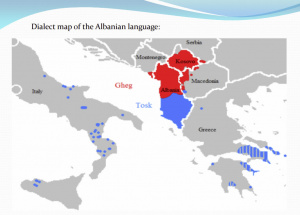Language/Tosk-albanian/Grammar/Gender
Hi Tosk Albanian learners! 😊
In this lesson, we will discover the concept of gender in Tosk Albanian. Gender is an important aspect of many languages and plays a significant role in communication. It is essential to understand gender to use the correct grammatical structures in a sentence. We will provide examples, cultural information and interesting facts to guide your learning process. Let's start!
Introduction[edit | edit source]
In the Albanian language, there are two genders: masculine and feminine. The gender of a noun is not predictable from its form and must be learned separately, making it an inflectional language. In some cases, there are different gender-specific endings for nouns. In most cases, gender is determined by the meaning of the word. However, this can vary depending on regional dialects.
With the completion of this lesson, consider investigating these related pages: How to Use Be & How to Use Have.
Gender Rules[edit | edit source]
Masculine Gender[edit | edit source]
The masculine gender includes male creatures, as well as things and concepts considered to be male or masculine. Here are some examples:
| Masculine Noun | Pronunciation | English |
|---|---|---|
| baba | baba | father |
| djalë | djalë | son |
| mal | mal | mountain |
| vaj | vaj | oil |
Feminine Gender[edit | edit source]
The feminine gender includes female creatures, as well as things and concepts considered to be female or feminine. Here are some examples:
| Feminine Noun | Pronunciation | English |
|---|---|---|
| nënë | nənə | mother |
| vajzë | vajzë | daughter |
| det | dɛt | sea |
| trëndafil | trəndafil | rose |
Common Gender[edit | edit source]
In Albanian, some words can have both masculine and feminine gender. For example, "profesor" can be either male or female. This is known as common gender.
| Common Gender | Pronunciation | English |
|---|---|---|
| profesor | profɛsor | teacher |
Neuter Gender[edit | edit source]
There is no neuter gender in Tosk Albanian. Inanimate concepts, ideas, and inanimate objects can be masculine or feminine, based on their meaning.
Examples[edit | edit source]
Here are some gender examples in sentences:
- Masculine: Unë kam një karroçë të re. (I have a new car.)
- Feminine: Ajo ka veshur një fustan të bukur. (She is wearing a beautiful dress.)
- Common: Profesori i historisë është shumë i zgjuar. (The history teacher is very smart.)
Now, let's practice with a short dialogue:
- Person 1: Si je, i dashur? (How are you, my dear?)
- Person 2: Mirë faleminderit, po ti?
(I'm fine, thank you. And you?) - Person 1: Unë jam mirë, flm. Kam blerë një libër të ri. (I'm good, thank you. I bought a new book.)
- Person 2: Çfarë libri është?
(What is the book about?) - Person 1: Është një libër historie. (It's a history book.)
Cultural Information[edit | edit source]
In Albanian, as well as in many other languages, gender plays an important role in society. The concept of masculinity and femininity defines how men and women are expected to behave, what is appropriate for them to do, and how they should interact with each other. Gender roles are deeply ingrained in Albanian society, and it is essential to understand them to communicate effectively.
Interesting Facts[edit | edit source]
Did you know that in Albanian, there are words that have both masculine and feminine endings? For example, the word "hamall" can be either "hamall" or "hamallor". It is interesting how the same word can have different genders, depending on the meaning and usage.
Conclusion[edit | edit source]
Gender is an integral part of understanding Tosk Albanian grammar. By mastering the concept of gender, you will be one step closer to speaking fluently and communicating effectively in Albanian. Practice with the examples provided, and don't forget to check out the Tosk Albanian Grammar page for further information. To improve your Tosk Albanian, you can also use the Polyglot Club website. Find native speakers and ask them any questions!
➡ If you have any questions, please ask them in the comments section below.
➡ Feel free to edit this wiki page if you think it can be improved. 😎
Sources[edit | edit source]
Great work on completing this lesson! Take a moment to investigate these connected pages: Future Tense & 0 to A1 Course.
Other Lessons[edit | edit source]
- Questions
- Give your Opinion
- Personal pronouns
- Nouns
- Pronouns
- Conditional Mood
- Adjectives
- How to Use Have
- How to Use Be
- Negation

